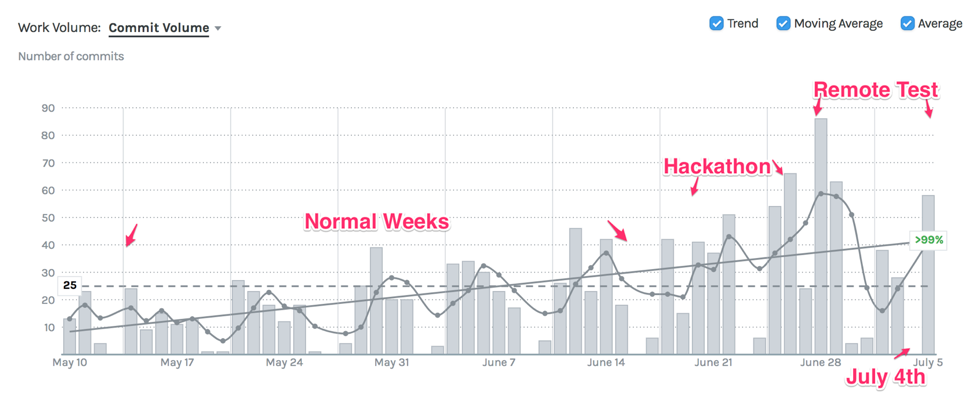How to take your Company Remote
Why Remote?
The benefits to having a remote-friendly environment are many and worthy of their own article, but the primary ones include:
- Talent is not limited by geography, opportunity historically has been
- Or rather, access to hiring the best and brightest means looking beyond your home city
- The data on Employee satisfaction and work/life integration is available and positive
- If you have one remote employee, congrats, you have a remote company
- Otherwise you have a second-class citizen employee who likely won’t last long
- Need to run 24/7 support or on-call shifts? Turns out timezones can help with this
- Productivity increases!
Ok, so how?
If you are a brand new company, it will be much easier for you to start with a remote-friendly culture, but for the rest of us, completely changing the office dynamics is a bumpy road. At Cratejoy, we decided to switch to a remote-friendly environment about 3 months ago, so we are still relatively new to it but here is what we have learned.
First, “remote-friendly” needs to be defined. We already generally had people working from home if they needed to occasionally. A trip to the doctor, an electrician, or car repair would be enough to sign in from home for the day with little issue. However, this doesn’t create real “remote” issues. Previously, we would move meetings, catch people up later, skip meetings, and generally make important decisions whenever said person was back in the office. You can’t do these things if people only come to the office twice a year.
So, when we said “remote-friendly” we meant some version of: on any given day we don’t care where you are physically, we should be able to accomplish all of the same things (if not more) than we would in the office.
Advice.
As the volunteer leader to make this happen, one of the first things I did was find as many people to talk to that had made a similar transition. The number of companies embracing remote work is only increasing and I found quite a few companies that were 6 to 12 months ahead of us in the process.
The best advice I heard over and over again was:
“It has to be the whole company, including the leadership team.”
and
“You don’t have to go full remote all at once.”
It has to be the whole company, including the leadership team because ambitious and smart people at the company will emulate what they see successful leaders doing. So if you want to drive real adoption, you have to do it too. But more importantly, everyone has to feel the pain. When we started, our conference rooms didn’t have real video conference equipment, so we dragged laptops in and set them on the table. We thought we were fine because we would ask remote people, can you hear us? Sure, they’d say because they don’t want to be a bother. When you are that remote person you realize that you are only going to hear about 60% of the conversation and your ability to contribute drops to basically zero.
You don’t have to go full remote all at once because, well, you have an office space probably and like every other change, this one is going to require some adjustments. It’s a good insurance plan to still have some time where you can clear up communication issues, reset expectations and check in in real life.
Step One.
Ok, so you have your advice, your reasons to do it, and your grit all ready to go. What’s first? The other important advice I got was to be ready to upset some people. This surprised me a bit because I thought I was about to announce a huge perk for everyone, and while that was true for a majority of people, there were people who liked the office and seeing people and other generally extroverted things.
Do an experiment.
Pick a small amount of time and announce that you are going to do an experiment for said amount of time where people can choose to work remotely or from the office. Then, empower your teams to come up with a few things:
- We need a clear way for how we are going to track progress and communicate about our goals.
- You probably were doing this to some degree already but now you need to communicate, online, asynchronously and pay attention more closely to not just goals but productivity as well (measure output as well as outcomes, this is a post for a different day)
- Schedules, in our case we decided Mondays would be a full-company onsite day and teams could choose to be onsite additional days if they wanted to.
- What does success look like? How do we know if we should keep doing this or not?
- Don’t start the experiment too soon after announcing to the team, they will need time to adjust: talk to their families, figure out their home office, etc.
My Mistakes.
At least the above is what I would have done for my first experiment. I ran an experiment before getting advice and here is how I messed it up.
- I started with just the Engineering department, that is my department why not start with it?
- Every other department immediately reacted, as they should, wondering why and how they could be involved.
- I announced it on Monday, we started it on Thursday.
- This was not enough time for people to acclimate.
- I forced everyone to stay away from the office, I leaned too hard into “feeling the pain” and didn’t think about the people who may have a tiny downtown 1-bedroom apartment and hate it.
Despite these mistakes, it was a resounding success. At the beginning, our primary concern was if working remotely could actually be as productive as being in the office. How do you know what people are doing? What keeps them from goofing off the whole time?
One of the tools I use to measure Engineering velocity is GitPrime, I highly recommend it as an Engineering leader as a quick gut check for how things are going. Here is the velocity chart I showed the rest of leadership after this experiment.
 We had a hackathon the week before the experiment so that primed the productivity of the team as well.
We had a hackathon the week before the experiment so that primed the productivity of the team as well.
Step Two.
Do another experiment.
After a few weeks back in the office, we did another experiment and this time I got it right. The whole company went remote, but we all showed up to the office on Mondays and people could choose where they work otherwise. This second experiment was scheduled to run a month but after a month, it was the new normal and so we extended it through the end of the year for now.
During this time, I ran weekly company health surveys to ask for feedback. Were there communication issues? Are you happy? Do you feel like you know what’s going on? I also worked with the rest of the leadership team to release a company-wide report on productivity of each department and if we are achieving our goals. This helps everyone feel like they know what their virtual neighbors are up to and that everyone is still working hard to make the company successful.
Some Cool Things.
As part of the survey I also asked if anyone had an opportunity to do something new or fun because of working remote and a few patterns started to emerge.
- People eat better and exercise more.
- They fit appointments and errands into their day to minimize time away.
- They go on lunch dates with their spouse (kid-free).
- They feel more rested in the evening, so they go out and be social during the week.
- They stop yelling at traffic every day.
- Some of them have a hard time turning off work, it’s too easy to work constantly.
- They are more satisfied and in control of their day.
Like I said, we are new at this and there are going to be new classes of problems to solve as we get further into it. But so far, there’s a lot to be gained by working more flexibly.

